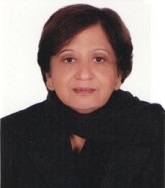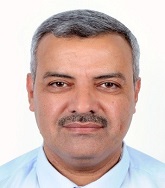Day :
- Pathophysiology and Disorders of ENT, Types and Treatment: ENT, Sinonasal Disorders and Surgical Treatment, Nasal Disorders & Surgery , Ear Disorders and Treatments, Tinnitus , Neurotology ,Laryngeal Disorders, Head and Neck Oncology, Rhinology and Hypersensitivity
Location: Osaka, Japan

Chair
Lakshmi Vaid, India
Director professor & head ENT Department in University College of Medical Sciences & GTB Hospital

Co-Chair
Ahmad Nasrat Al-juboori, Qatar
Associate consultant in Hamad Medical Corporation
Session Introduction
Christen-Zen I. Sison
3rd year of residency with the Department of Otorhinolaryngology-Head & Neck Surgery at the University of Santo Tomas Hospital
Title: Unilateral Sensorineural Hearing Loss Secondary to Internal Auditory Canal Stenosis in a 12-year old Female: A Therapeutic Dilemma

Biography:
Dr. Christen-Zen I. Sison earned her B.Sc. Degree Double Major in Biology and Kinesiology at the York University in Toronto, Canada in 2008. She went on to complete her M.D. Degree from the University of Santo Tomas Faculty of Medicine and Surgery in 2014. She is currently in her 3rd year of residency with the Department of Otorhinolaryngology-Head & Neck Surgery at the University of Santo Tomas Hospital in Manila, Philippines.
Abstract:
Unilateral hearing loss is a significant complaint that is often encountered in otolaryngology practice and if left uninvestigated, it may have dire consequences. In this case, we encountered a rare condition of a 12-year old girl who initially presented with progressive unilateral sensorineural hearing loss, with no evidence of facial palsy. Neuroimaging demonstrated stenosis of the internal auditory canal. Isolated cases of congenital primary stenosis of the internal auditory canal (IAC) is a rare condition although other temporal bone conditions may also accompany this condition. Even though the majority of patients exhibit sensorineural hearing loss, there are also cases wherein the hearing is normal in patients with stenotic canals, leading several studies to investigate the causal link between this anatomic abnormality and deafness. Typical radiographic findings are described in this case, and the relevant embryological origins of the ear are traced in detail. The association of isolated IAC stenosis and hearing loss in this case suggests a correlation between stenosis and deafness. Most of the literature is focused on the effect of IAC stenosis on the outcome of cochlear implantation. There is currently no consensus regarding the therapeutic management for these types of cases since there are only a few reports in literature.
Jenina Rachel D.J. Escalderon
Otorhinolaryngology- head and neck surgery resident
Title: Surgical Outcomes of Type 1 Tympanoplasty on Microscopic Technique Post-Auricular Approach and Endoscopic Technique Transcanal Approach: A Single Surgeon Experience

Biography:
Jenina Rachel D.J. Escalderon, MD has completed her medical degree at the age of 24 years from from University of Santo Tomas, Manila , Phillipines. She is currently an otorhinolaryngology- head and neck surgery resident at the same hospital.
Abstract:
Conventionally, tympanoplasty is a surgical procedure that utilizes the microscope to visualize tympanic membrane and the middle ear. In years past, the use of endoscopes has been limited to paranasal sinus surgeries.1 Several reports have been made on endoscopic tympanoplasty worldwide.1-5 However, there is a scarcity of studies in the Philippines assessing the capacity for endoscopic techniques on micro-otologic surgery. This study aims to describe the surgical outcomes of patients who underwent endoscopic vs microscopic technique in Tympanoplasty.
Methodology: Review of charts from 2015 to 2017 were done. Patients who underwent Type 1 tympanoplasty by a single surgeon via endoscopic or microscopic approach were included in the study. Tympanic membrane integrity, operative time and complications were noted.
Results: 19 patients were included in the study. The mean age of patients was 43 for Microscopic and 48 for Endoscopic Tympanoplasty. Mean operative time was 140.6 minutes (SD±43.3) for Microscopic and 86.7 minutes(SD=±13.0) for Endoscopic Tympanoplasty. Majority of patients were male. There was 100% tympanic membrane integrity on both techniques. Hearing results for air conduction pure tone average from 500, 1000, 2000 and 4000 Hz showed improvement in hearing with a gain of more than 10dB on 5 patients via endoscopic tympanoplasty. For bone conduction PTA, there was noted improvement among 5 patients via microscopic tympanoplasty. Change in air-bone gap showed improvement by more than 10dB on 5 patients via microscopic tympanoplasty
Conclusion: Endoscopic Tympanoplasty is an alternative to microscopic tympanoplasty. It has a high success rate in closure of perforation and yields less operative time.
Valerie Kaye U. Sison
Second year resident at the Department of Otorhiolaryngology – Head and Neck Surgery
Title: Ossifying Fibroma, Bilateral: Management Dilemma in a 16 year Old Male, A Case Report

Biography:
Dr. Valerie Kaye U. Sison is currently a second year resident at the Department of Otorhiolaryngology – Head and Neck Surgery at the University of Santo Tomas Hospital. She completed her Bachelor of Science in Medical Technology and Doctor of Medicine degree at the University of Santo Tomas.
Abstract:
Objectives:
To present a case of ossifying fibroma maxillary alveolar ridge presenting as upper gingival mass in a 16-year old male, extracted via partial excision (shaving) of maxillary alveolar mass, bilateral.
To review the prevalence of ossifying fibroma
To know what are the other types of bony tumor which may present similarly with ossifying fibroma
Design: Case Report
Setting: Private Division of a Tertiary Hospital
Patient: Patient is a 13-year old male presenting with bilateral upper gingival mass
Results: Patient was initially diagnosed with Benign Fibroosseus Lesion t/c Fibrous Dysplasia vs Ossifying Fibroma maxillary Alveolar Ridge, Bilateral upon CT scan, he was then scheduled for Partial Excision (Shaving) of Maxillary Alveolar Mass, Bilateral Intraoperatively, 0.5 x 1 – 2 cm bony fragments and 1 – 2 cm bony fragments were obtained from the left and right alveolar ridge were obtained respectively.
Veronica Marie M. Mendoza
Chief resident of the UST Hospital Department of Otorhinolaryngology- Head and Neck Surgery
Title: Peripheral T-Cell Lymphoma: Unusually Presenting as an Auricle Mass

Biography:
Dr. Veronica Marie M. Mendoza completed her doctorate degree in Medicine at the University of Santo Tomas- Faculty of Medicine and Surgery. She is currently on her fourth year of residency training as chief resident of the UST Hospital Department of Otorhinolaryngology- Head and Neck Surgery. She has published a case report in one of the local journals and has presented several of her researched in various international conferences.
Abstract:
Objective: To present a rare case of Peripheral T-cell Lymphoma in a 64-year old male presenting with an auricular mass on the right ear
Methods:
Study Design: Case Report
Setting: Tertiary Private Hospital
The patient is a 64-year old male with a 7-month history of progressively enlarging mass on the auricle of the right ear accompanied by pruritus and yellowish discharge, initially treated as a case of Perichondritis which did not resolve. Initial biopsy showed Fibrocollagenous tissue with chronic inflammation whereas repeat incision biopsy revealed Atypical Round Cell Lesion. Immunohistochemical study was consistent with Peripheral T-cell Lymphoma, not otherwise specified, Stage II. The patient underwent 6 cycles of chemotherapy.
When evaluating patients with a non-traumatic auricular deformity that presents like a soft tissue infection unresponsive to antibiotic therapy and progressively resembles a tumor, immediate biopsy and imaging should be instituted to obtain an accurate diagnosis and avoid unnecessary procedures. After all, not all head and neck masses are managed with surgery.
This case of PTCL-NOS of the auricle, just like other reported cases of lymphoma arising from the external auditory canal appear to respond well with the standard CHOP regimen. Therefore, the favorable resolution in our case suggest that surgical resection of the auricle should be reserved for cases non-responsive to the standard treatment for lymphoma.
Teerapol Kotamnivates
Otorhinolaryngology- head and neck surgery resident
Title: Transaxillary endoscopic thyroidectomy: gas insufflation versus gasless technique

Biography:
Teerapol Kotamnivates has completed his MD from Thammasat University. Currently he is during the residency program of Otolaryngology Head and Neck Surgery, Prince of Songkla University.
Abstract:
To compare the clinical outcomes between gas insufflation and gasless technique of transaxillary endoscopic thyroidectomy.
Materials & Methods:
During June 2011 to August 2017 a total of 60 patients underwent transaxillary endoscopic thyroidectomy. All patients were operated by one surgeon. Gas insufflation technique was performed in 38 patients and gasless technique was performed in 22 patients. The clinical outcomes were compared between the both groups.
Results:
The patients’ characteristics were not different between the two groups. The operative time for the gas insufflation group was shorter than in the gasless group (209.3±63.1 vs. 267.6±66 min; P = 0.001). The estimate blood loss for the gas insufflation group was less than in the gasless group (10(5,20) vs. 30(16.2,50) mL; P <0.001). The drainage content was significantly less in the gas insufflation group (0 (0,70) vs. 81.5(74.2,104.5) mL; P<0.001). The hospitalized days were significantly less in the gas insufflation group (1.5 (1.1,2) vs. 1.8(1.5,2.5) day; P=0.032) Regarding of pain between the gas insufflation and gasless groups, there was no statistically significant difference of VAS at 24 and 48 hours. Morbidity and other complications were comparable across groups. Tract recurrence was not found in the both groups
Conclusion:
Compared to the gasless technique, the gas insufflation technique provided better clinical outcomes in terms of operative time, estimate blood loss, drainage content, and hospitalized day. There were comparable outcomes regarding the postoperative pain, complication and tract recurrence.
